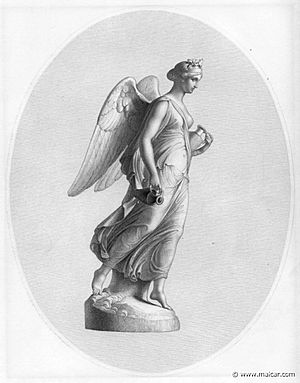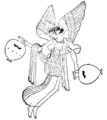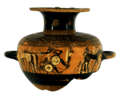Eos facts for kids
Quick facts for kids Eos |
|
|---|---|
| Personification of the Dawn | |
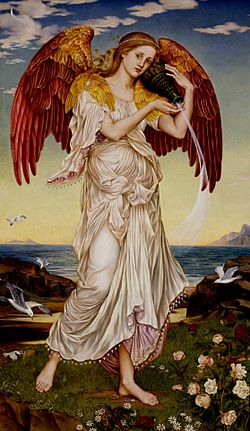
Eos by Evelyn De Morgan (1895)
|
|
| Ancient Greek | Ἠώς |
| Abode | Sky |
| Animals | Cicada, horse |
| Symbol | Saffron, cloak, roses, tiara |
| Color | Red, white, pink, gold, saffron |
| Mount | A chariot drawn by two horses |
| Personal information | |
| Consort | Astraeus, Orion, Cephalus, Cleitus, Ares, Tithonus |
| Children | The Winds (Boreas, Eurus, Notus and Zephyr), the Stars (Eosphorus/Hesperus, Pyroeis, Stilbon, Phaethon, and Phaenon), Memnon, Emathion, and Astraea |
| Parents | Hyperion and Theia |
| Siblings | Helios and Selene |
| Equivalents | |
| Roman equivalent | Aurora |
| Etruscan equivalent | Thesan |
| Slavic equivalent | Zorya |
| Hinduism equivalent | Ushas |
| Japanese equivalent | Ame-no-Uzume |
In ancient Greek mythology, Eos is the goddess of the dawn. She is often shown as a beautiful woman. Each morning, Eos rises from her home at the edge of the great river Oceanus. Her job is to bring light to the world and make the night disappear.
Eos is the daughter of the Titans Hyperion and Theia. She is also the sister of the sun god Helios and the moon goddess Selene.
Every day, Eos drives her two-horse chariot across the sky. She announces the start of a new day and the arrival of her brother, Helios. Because of the beautiful colors in the sky at dawn, Eos is often called "rosy-fingered." She is also known as "early-born" because she appears so early. Sometimes, Eos even stays with Helios for his whole journey across the sky. This means you might see her colors even during dusk.
Eos appears in many old stories and poems. However, people in ancient Greece did not worship her much.
Contents
What Eos Looks Like
Eos is almost always described with rosy fingers or forearms. This is because she opens the gates of heaven for the Sun to rise. On ancient Greek vases, she is shown as a beautiful woman. She wears a saffron-colored cloak and a tiara or crown. She also has large, white bird-like wings.
Sometimes, Eos is shown spreading dew from an upside-down pot. Other times, she holds a torch and rides her chariot. The morning star, Eosphorus, often flies with her.
Myths About Eos
Eos leaves her home by the ocean every morning. She goes to wake up her brother, Helios. She opens the gates of heaven so Helios can ride his chariot across the sky each day.
Eos and Tithonus
The story of Eos and Tithonus is a very old myth. Eos fell in love with Tithonus, a handsome prince from Troy. She wanted him to live forever. So, she asked Zeus, the king of the gods, to make Tithonus immortal. Zeus agreed and granted her wish.
However, Eos forgot to ask for eternal youth for Tithonus. For a while, they lived happily in her palace. But Tithonus started to age. He never died, but he kept getting older and weaker. Soon, he could not even move. Eos eventually locked him in a room. He withered away alone, forever an old man. Out of pity, Eos changed him into a small bug called a cicada.
This myth might explain why cicadas make a lot of noise in the early morning. This is when the dawn goddess Eos appears.
Eos and Cephalus
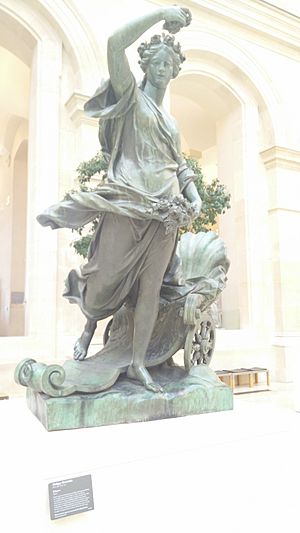
The story of Eos taking Cephalus was very popular in ancient Athens. Cephalus was from that area. Eos carried Cephalus off while he was hunting and took him to Syria.
Cephalus was already married to Procris. Eos and Cephalus had three sons together. But Cephalus missed Procris very much. Eos was unhappy about this. She returned him to Procris, but she made him wonder if Procris had stayed loyal to him.
Cephalus, worried by Eos's words, decided to test Procris. He changed his appearance to look like a stranger. He offered to marry Procris. At first, she said no, but eventually she agreed. Cephalus was hurt by this. The couple separated for a while but later got back together.
Later, Procris became suspicious of Cephalus. When he was hunting, he would often call out to the breeze, "Aura," to cool himself. Procris thought he was calling out to another woman. She followed him and spied on him. Cephalus, mistaking her for a wild animal, threw his spear and accidentally killed his wife.
Related pages
- Aurora - The Roman mythology version of Eos.
- Thesan - The Etruscan mythology version of Eos.
Images for kids
-
Eos in her four-horse chariot, terracotta red-figure lekanis vase, late 300s BC, Canosa, Metropolitan Museum of Art.
-
The fight of Achilles and Memnon, with their mothers Thetis and Eos watching, late Corinthian Black-Figure hydria, circa 575-550 BC, now in the Walters Art Museum.
-
Eos with two young men, red-figure stamnos, ca 470–460 BC, now in the Walters Art Museum.
-
Eos in her chariot flying over the sea, red-figure krater from Southern Italy, 430–420 BC, Staatliche Antikensammlungen.
-
Eos the Morn, an engraving by John Flaxman.
-
Eos and Tithonus, by Sebastiano Ricci.
See also
 In Spanish: Eos para niños
In Spanish: Eos para niños



